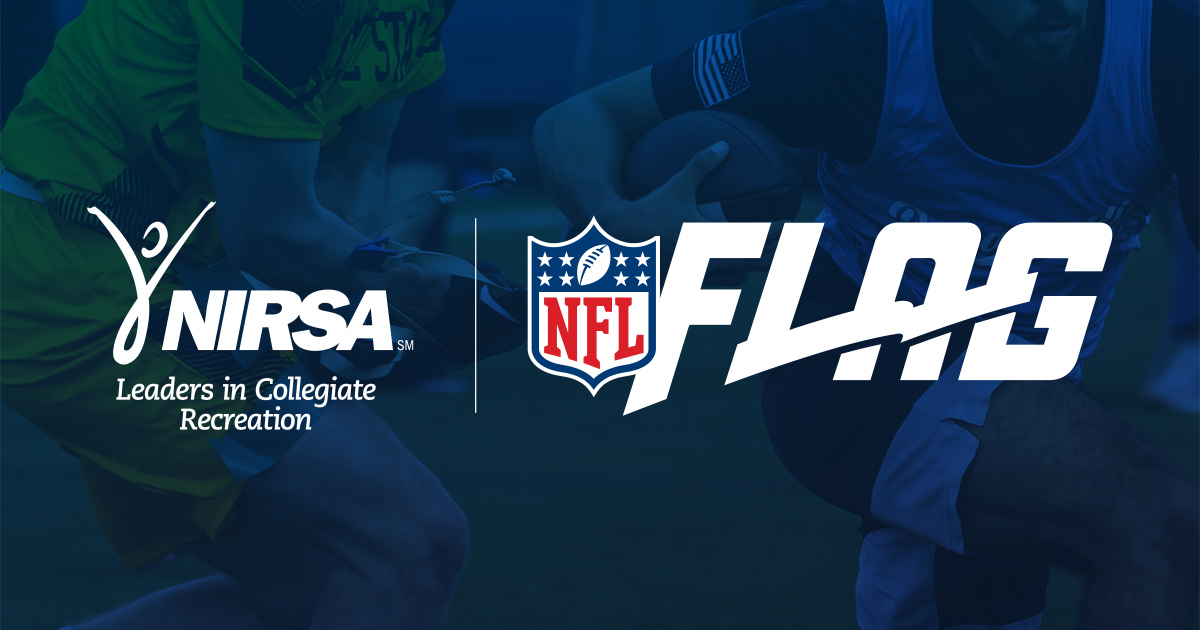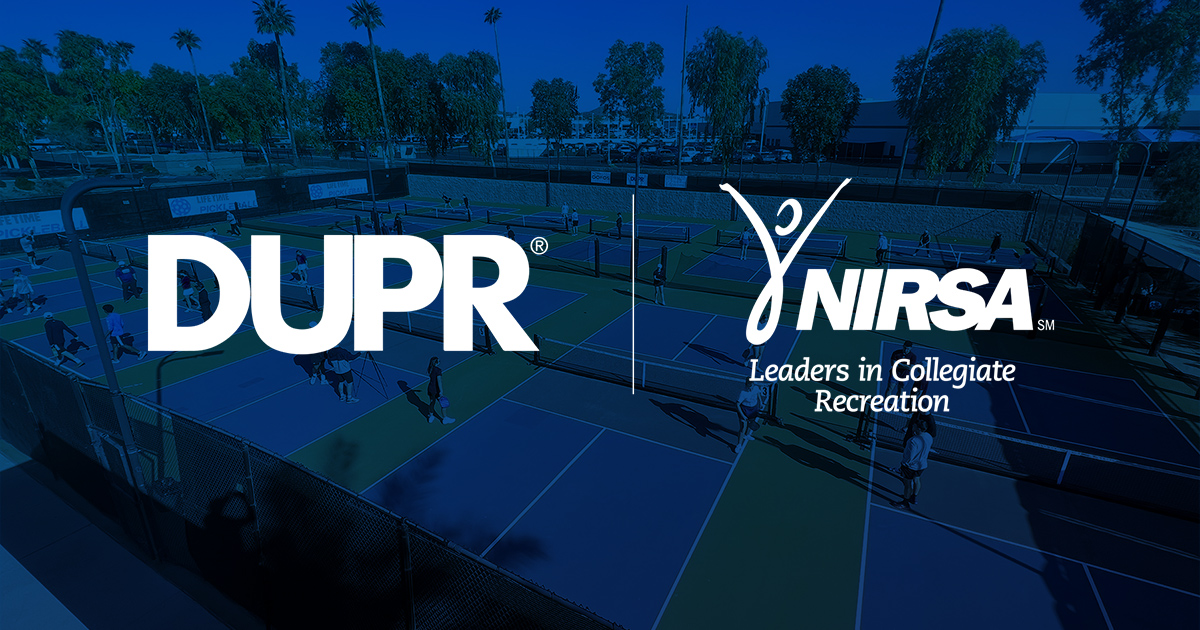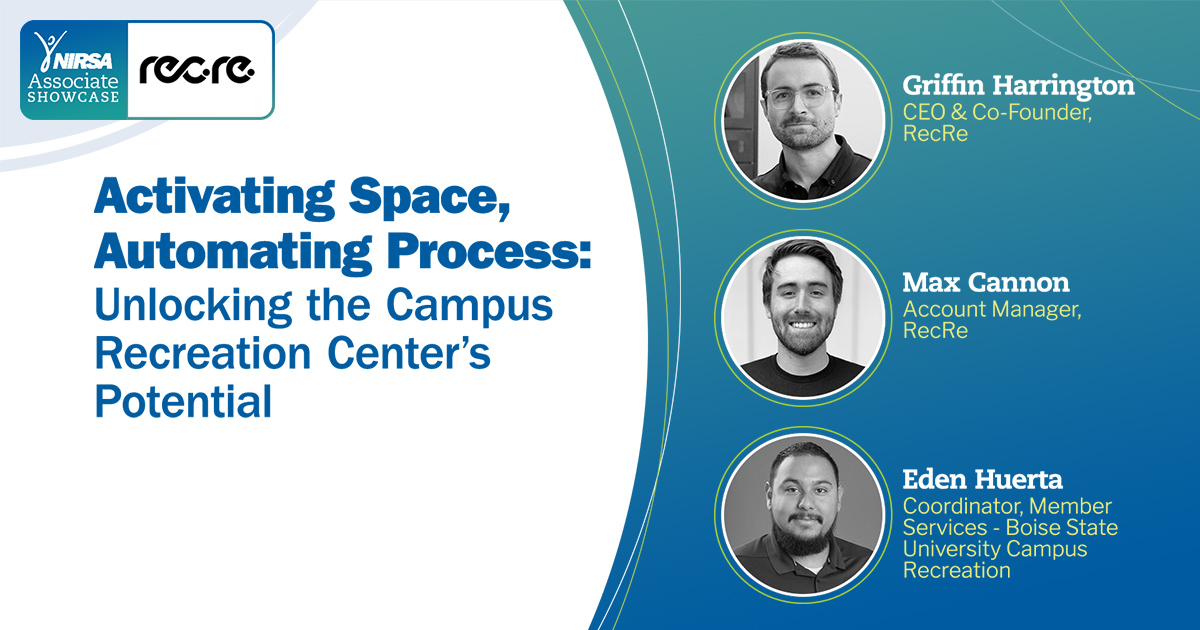Outdoor fitness spaces can save college and university recreation centers big bucks per square foot versus indoor spaces; allow for unique, intentional programming; and encourage student wellbeing through exploration and play. These insights emerged among other key takeaways in an April 19 webinar presented by PLAE.
Using Florida Gulf Coast University’s “Rec Deck” as an example of innovative outdoor recreation, the webinar is a can’t-miss overview of the importance of outdoor fitness spaces, the expenses involved, and successful programming tips. Recorded access to “It’s a Great Day to PLAE Outdoors: Funding, Designing & Programming an Outdoor Fitness Space” is available for NIRSA members and non-members alike, who can view the free recording by registering here.
After the webinar, PLAE also selected one lucky attendee—Laure Butcher, Assistant Director, Personal Training/OPL at Auburn University—to win a complimentary registration to the NIRSA 2023 Annual Conference & Campus Rec and Wellness Expo in Pittsburgh, PA. Congratulations, Laure!
Exploration cultivates physical activity and mental health
Brittany Barrett, PLAE Director of Campus Recreation Business Development, kicked off the webinar with a look at past outdoor recreation trends like fitness trails and challenge courses, noting that outdoor functional fitness training is relatively new. “Our goal is to create environments that stimulate physical play in adults,” Brittany said.
She explained this pushed PLAE to focus its outdoor fitness spaces on encouraging the “fundamental human urge” of exploration, an essential concept in human development that slows as we age out of childhood. Physical movement, mental health, and enjoyment work in conjunction to achieve “play.” An environment that promotes exploration and play also provides students an outlet for building coping mechanisms and resilience.
“If we are able to create training environments that inspire our students, they’re very engaging, or they offer this sense of exploration, we’re probably going to have an easier time promoting and taking strides to improving our health,” Brittany said in the webinar.
Outdoor fitness expenses can be 80% less than indoor spaces
Getting its exploration-promoting, outdoor Rec Deck was many years in the making for FGCU. Suzanne Ries, FGCU’s Interim Director & Associate Director, Facility Operations, described the multi-phase master planning process for FGCU’s new recreation center. When planning started in 2016, students had to share indoor rec space with athletics in an 8,700 square foot building. Because of the limited room, they were already taking rec programming outdoors and wanted to see this trend continue.
FGCU investigated numerous outdoor equipment systems and vendors, but the outdoor rec space was as add-alternate in the master plan, and funding was not included in first-phase funding.
FGCU’s new University Recreation & Wellness Center opened in February 2020, closed in March due to the pandemic, and reopened in August. That summer, Suzanne received exciting news that leftover funds in the construction budget would allow for the new, dedicated outdoor fitness space to become a reality. While initial talks with PLAE in 2017 didn’t reveal the type of outdoor environment FGCU wanted, by 2020, PLAE had partnered with another company to offer container gyms, and the new concept was more in alignment with FGCU’s vision for the space.
Suzanne cited functionality, allowance for informal and formal programming, and weight training as must-haves. FGCU was also intentional with its architectural plan, wanting the outdoor training environment to feel like part of the facility, flowing from inside to outside.
In the webinar, Suzanne described some key takeaways for campuses to consider in planning an outdoor fitness space and broke down the project’s major expenses. In total, costs were $639,000 for the new Rec Deck.
“For those that are familiar with the going rate to build indoor recreation space: Right now, it’s about $500 per square foot,” Suzanne said. “I’m not making this up, we added 6,300 square feet of space to our existing facility in this outdoor space. So you break that down, it ended up being [about] $100 per square [foot].”
“Yeah, that bottom line might look hefty,” she continued, referring to the total project cost, “but it is relatively inexpensive when you compare it to trying to expand interior space.”
Rec Deck draws significant student participation and new forms of programming
And the result? Students can’t get enough.
Lisa Caldwell, FGCU Assistant Director Fitness Programs, illustrated how new students on orientation tours are awed by the Rec Deck, which simultaneously offers space for functional training, Olympic lifting, bodyweight fitness, and group fitness classes. “When they get to walk out into the Rec Deck and experience the space, it really is a ‘wow factor’ for them,” she said.
It’s great for staff, too, as the Rec Deck offloads crowded, overused space in FGCU’s indoor facility, preventing lines for equipment even during peak hours. Lisa also noted that staff could manage the Rec Deck as part of its regular rounds, so no additional supervision was needed.
Class instructors can deliver more intentional, interactive education unencumbered by the noise and crowds of the indoor rec center. FGCU added unique programming, such as group Olympic lifting and “CrossFit-esque” functional training classes, which can be done on a circuit on the Rec Deck without running across the whole indoor gym for various equipment needs.
Lisa explained some unforeseen takeaways, like increased female and new weightlifter participation, and observed a major benefit in the ability to concurrently host open recreation alongside group fitness classes. “The Rec Deck provides a more secluded space to…learn and play and try something new you haven’t done before without feeling like people are watching,” she said.
For more programming ideas, planning and budget considerations, and benefits of exercise through exploration, register now to view the free, recorded webinar by PLAE.
About PLAE
PLAE has been a NIRSA associate member and exhibitor for a decade. Sponsorship at the regional level grew to national-level involvement in 2015, and PLAE signed its first Diamond Partnership agreement at the end of 2018—a partnership that continues today. PLAE engineers high-end sports flooring specifically designed for maximum shock absorption and explosive energy return. Specialties are weight rooms, indoor/outdoor turf, gymnasiums, track systems, and multi-purpose surfaces.
- For more information about NIRSA’s Associate Showcase and sponsored content opportunities, please contact NIRSA Expo & Corporate Relations Coordinator Kelley Hungerford.
Kelley Hungerford is currently the Assistant Director of Expo & Corporate Relations at NIRSA.







